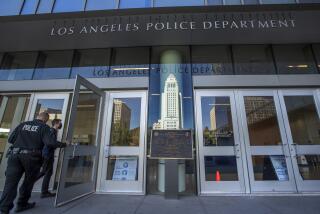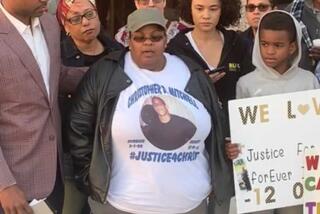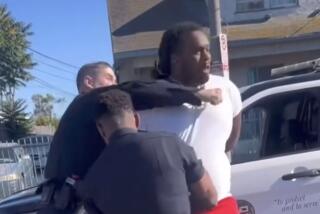Evidence in Shooting Backs Police, Chief Says
- Share via
Calling the killing of Margaret Mitchell “a tragedy” for everyone involved, Los Angeles Police Chief Bernard C. Parks on Tuesday offered previously unreleased evidence that he says supports two LAPD officers’ version of events in the controversial shooting of the 55-year-old homeless woman last May.
Speaking at a news conference at Parker Center, the chief cited the results of an autopsy and gunshot residue tests that he says are consistent with the statement of Officer Edward Larrigan, who says he shot Mitchell in self-defense as he and his partner attempted to question the mentally ill woman about a shopping cart they suspected her of stealing.
Larrigan and his partner, Kathy Clark, stopped Mitchell as she pushed the cart filled with her belongings down a sidewalk near La Brea Avenue and 4th Street.
As soon as the officers confronted Mitchell, she became belligerent, threatening to kill them, and eventually brandishing a 12-inch screwdriver, according to police. Larrigan, 28, said he shot Mitchell from a crouched, off-balance position as she lunged toward his neck with the screwdriver.
The chief said an autopsy revealed that the bullet entered Mitchell’s chest, traveling on an upward trajectory and came out her back. He said the gunshot residue tests performed on Mitchell’s clothing and body showed that she was one to six feet from Larrigan when the officer fired, and that the hand in which she was allegedly holding her screwdriver “was in close proximity to the officer’s firearm.”
“The officer’s account of the incident is consistent with the physical evidence,” Parks said.
Parks noted that eyewitnesses to the shooting provided investigators with varying accounts. In fact, police documents show, one witness close to the incident said it was Clark who shot Mitchell, even though the officer never fired her gun.
According to summaries of statements the LAPD distributed Tuesday, witnesses also gave different accounts as to whether Mitchell was a threat to the officers at the time she was shot. One witness said she was running away, while another declared that Mitchell “had something in her right hand and was moving it side to side, something like waving a sword.”
Parks said that before the shooting Officer Clark recognized Mitchell as “possibly” being a transient “known to . . . officers for her explosive and violent nature.” The chief said Clark communicated that information to her partner.
Witnesses who knew Mitchell from the neighborhood, and who were interviewed by police, said she was not known to be hostile.
“I was under the impression she had a mental condition, episodes of shouting, nothing violent,” said one witness.
Parks said he took the unusual step of releasing the normally confidential officer-involved shooting report due to intense interest in the shooting, which sparked outrage among community activists. Critics questioned why Larrigan had to resort to deadly force against a 5-foot, 1-inch, 102-pound woman armed with a screwdriver.
Park declined to comment on his own written assessment of the shooting, which is under review by the civilian Police Commission. But sources familiar with his report say that the chief, while finding the shooting in policy, strongly criticizes some of Larrigan’s tactics.
Specifically, Parks found that the officer missed an opportunity to disarm Mitchell after she had threatened to kill him and his partner.
More to Read
Sign up for Essential California
The most important California stories and recommendations in your inbox every morning.
You may occasionally receive promotional content from the Los Angeles Times.










